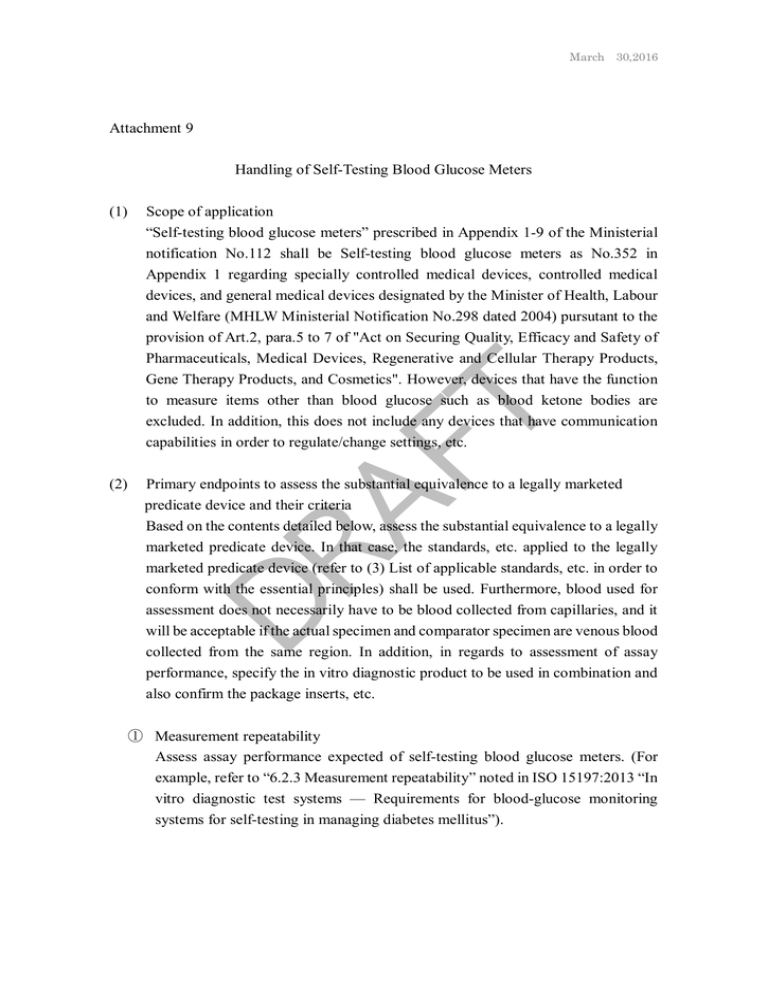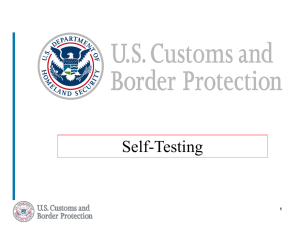Attachment 9 Handling of Self-Testing Blood Glucose Meters (1
advertisement

March 30,2016 Attachment 9 Handling of Self-Testing Blood Glucose Meters Scope of application “Self-testing blood glucose meters” prescribed in Appendix 1-9 of the Ministerial notification No.112 shall be Self-testing blood glucose meters as No.352 in Appendix 1 regarding specially controlled medical devices, controlled medical devices, and general medical devices designated by the Minister of Health, Labour and Welfare (MHLW Ministerial Notification No.298 dated 2004) pursutant to the provision of Art.2, para.5 to 7 of "Act on Securing Quality, Efficacy and Safety of Pharmaceuticals, Medical Devices, Regenerative and Cellular Therapy Products, Gene Therapy Products, and Cosmetics". However, devices that have the function to measure items other than blood glucose such as blood ketone bodies are excluded. In addition, this does not include any devices that have communication capabilities in order to regulate/change settings, etc. (2) Primary endpoints to assess the substantial equivalence to a legally marketed predicate device and their criteria Based on the contents detailed below, assess the substantial equivalence to a legally marketed predicate device. In that case, the standards, etc. applied to the legally marketed predicate device (refer to (3) List of applicable standards, etc. in order to conform with the essential principles) shall be used. Furthermore, blood used for assessment does not necessarily have to be blood collected from capillaries, and it will be acceptable if the actual specimen and comparator specimen are venous blood collected from the same region. In addition, in regards to assessment of assay performance, specify the in vitro diagnostic product to be used in combination and also confirm the package inserts, etc. DR AF T (1) ① Measurement repeatability Assess assay performance expected of self-testing blood glucose meters. (For example, refer to “6.2.3 Measurement repeatability” noted in ISO 15197:2013 “In vitro diagnostic test systems — Requirements for blood-glucose monitoring systems for self-testing in managing diabetes mellitus”). March 30,2016 ② Intermediate measurement precision Assess assay performance expected of self-testing blood glucose meters. (For example, refer to “6.2.4 Intermediate measurement precision” noted in ISO 15197:2013 “In vitro diagnostic test systems — Requirements for blood-glucose monitoring systems for self-testing in managing diabetes mellitus”). ③ System accuracy Assess assay performance expected of self-testing blood glucose meters. (For example, refer to “6.3 System accuracy” noted in ISO 15197:2013 “In vitro diagnostic test systems — Requirements for blood-glucose monitoring systems for self-testing in managing diabetes mellitus”). DR AF T ④ Packed cell volume evaluation Assess assay performance expected of self-testing blood glucose meters. (For example, refer to “6.4.3 Packed cell volume evaluation” noted in ISO 15197:2013 “In vitro diagnostic test systems — Requirements for blood-glucose monitoring systems for self-testing in managing diabetes mellitus”). ⑤ Interference testing Assess assay performance expected of self-testing blood glucose meters. (For example, refer to “6.4.4 Interference testing” noted in ISO 15197:2013 “In vitro diagnostic test systems — Requirements for blood-glucose monitoring systems for self-testing in managing diabetes mellitus”). (3) List of applicable standards, etc. in order to conform with the essential principles In regards to conformity with certification standards, applicable standards, etc. to explain compliance with essential principles are as follows. Conformity with the requirements of the stanards, etc shall be demonstrated when demonstrating compliance with essential principles. In addition, if conformity with these standards, etc. cannot be demonstrated, one can demonstrate compliance with essential principles with adequate justification for any deviation from the standards. ① Standards to be used to assess the substantial equivalence • ISO 15197:2013, In vitro diagnostic test systems — Requirements for bloodglucose monitoring systems for self-testing in managing diabetes mellitus March 30,2016 DR AF T ② Other • JIS Q 13485, Medical devices – Quality management systems – Requirements for regulatory purposes • ISO 13485, Medical devices – Quality management systems – Requirements for regulatory purposes • JIS T 14971, Medical devices – Application of risk management to medical devices • ISO 14971, Medical devices – Application of risk management to medical devices • JIS C 1010-1, Safety requirements for electrical equipment for measurement, control, and laboratory use – Part 1: General requirements • IEC 61010-1, Safety requirements for electrical equipment for measurement, control, and laboratory use – Part 1: General requirements • JIS C 1010-2-101, Safety requirements for electrical equipment for measurement, control, and laboratory use – Part 2-101: Particular requirements for in vitro diagnostic (IVD) medical equipment • IEC 61010-2-101, Safety requirements for electrical equipment for measurement, control, and laboratory use – Part 2-101: Particular requirements for in vitro diagnostic (IVD) medical equipment


